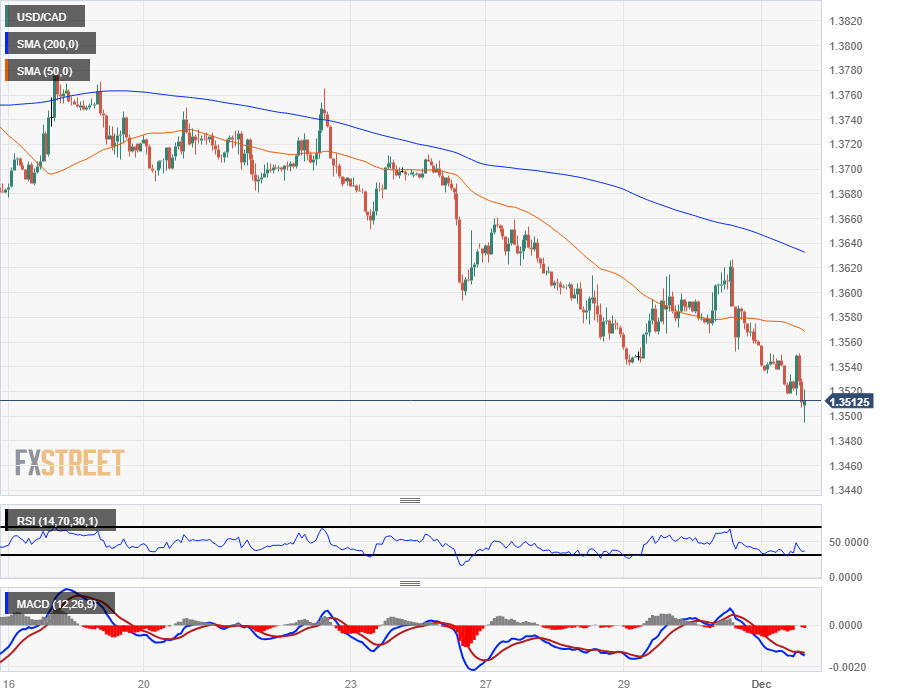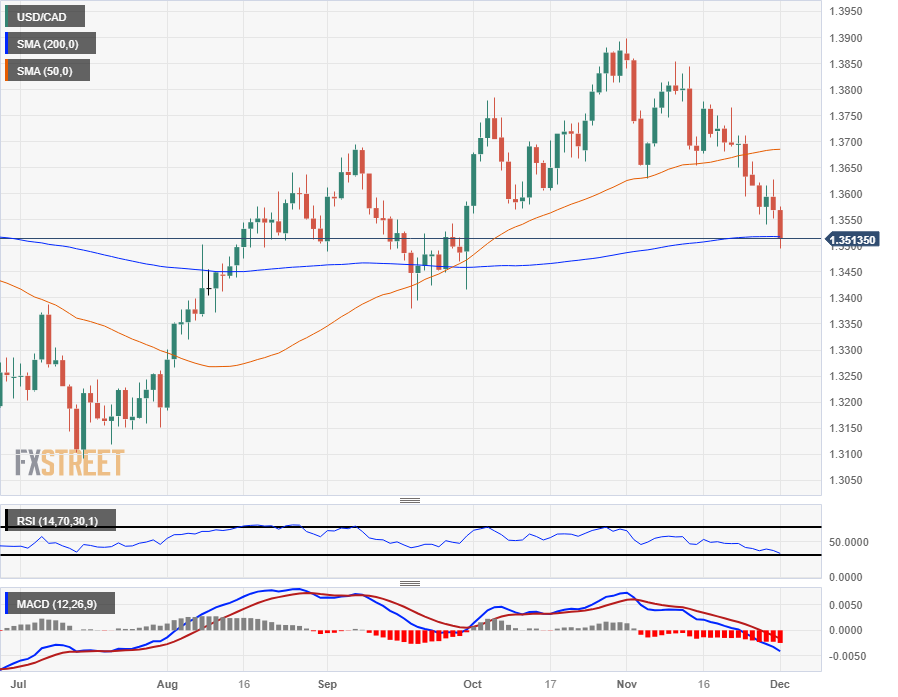Canadian Dollar testing higher ground after Canada adds more jobs than expected

Most recent article: Canadian Dollar gains across the board on Thursday despite mixed Canadian GDP growth
- Canadian Dollar sees further gains heading into the end of the trading week.
- Canada’s new job hiring outpaced market expectations, but the unemployment rate ticked slightly higher.
- Canadian wage growth holds steady at 5%.
The Canadian Dollar (CAD) is testing higher ground in Friday trading, climbing once more against its largest peer, the US Dollar (USD), after Canadian employment figures handily trounced market expectations. The Canadian Dollar is one of the top-performing currencies for the week, having gained a full percent against the US Dollar from Monday’s opening bids.
Canada added almost twice as many jobs as the median market forecast expected in November, showing almost 25K new hires against the forecast of 15K, increasing the pace of new job additions from October’s 17.5K.
The Canadian Unemployment Rate ticked slightly higher to 5.8%, in line with investor expectations, and Average Hourly Wages for the year into November held steady with October’s print of 5%, helping to ease demand-driven inflation concerns as Canadian wage growth remains capped under 6%.
Daily Digest Market Movers: Canadian Dollar is on the move against the US Dollar once more, challenging 1.3500
- The Canadian Dollar is up three-tenths of a percent against the US Dollar on Friday.
- Canada added 24.9K jobs in November compared to the previous 17.5K, beating expectations of a 15K print.
- Despite beating market forecasts, Canadian hiring remains below 2023’s peak print of 150K in February.
- CAD supremacy is limited by a slight decline in the Canadian S&P Global Manufacturing Purchasing Managers Index (PMI), which slipped from 48.6 to 47.7.
- The Canadian Unemployment Rate slightly increased from 5.7% to 5.8%, but markets broadly anticipated this figure.
- The CAD is still shrugging off Thursday’s Gross Domestic Product (GDP) backslide after quarterly GDP unexpectedly declined 1.1% for the third quarter. Investors are instead focused on the extreme upside revision of 2Q’s GDP growth from -0.2% to 1.4%.
- Crude Oil markets are as volatile as ever but continue to range as fossil fuel investor sentiment plays tug-of-war between declining global demand concerns and a fresh batch of Organization of the Petroleum Exporting Countries (OPEC) Crude Oil production cuts set to continue through Q1 2024.
Canadian Dollar price today
The table below shows the percentage change of Canadian Dollar (CAD) against listed major currencies today. Canadian Dollar was the strongest against the Euro.
| USD | EUR | GBP | CAD | AUD | JPY | NZD | CHF | |
| USD | 0.12% | -0.45% | -0.50% | -0.87% | -0.75% | -0.65% | -0.51% | |
| EUR | -0.12% | -0.60% | -0.65% | -1.04% | -0.91% | -0.80% | -0.61% | |
| GBP | 0.45% | 0.58% | -0.05% | -0.41% | -0.29% | -0.20% | -0.05% | |
| CAD | 0.50% | 0.64% | 0.06% | -0.40% | -0.24% | -0.14% | 0.04% | |
| AUD | 0.86% | 1.03% | 0.45% | 0.40% | 0.14% | 0.24% | 0.42% | |
| JPY | 0.74% | 0.93% | 0.32% | 0.24% | -0.11% | 0.14% | 0.29% | |
| NZD | 0.65% | 0.80% | 0.21% | 0.15% | -0.24% | -0.10% | 0.18% | |
| CHF | 0.47% | 0.59% | 0.03% | -0.03% | -0.39% | -0.27% | -0.18% |
The heat map shows percentage changes of major currencies against each other. The base currency is picked from the left column, while the quote currency is picked from the top row. For example, if you pick the Euro from the left column and move along the horizontal line to the Japanese Yen, the percentage change displayed in the box will represent EUR (base)/JPY (quote).
Technical Analysis: Canadian Dollar pushing for an additional day of gains against the US Dollar
The Canadian Dollar (CAD) continued its climb against the US Dollar (USD) on Friday, sending the USD/CAD down to the 1.3500 handle in Friday trading, and the pair is currently snarled along the 200-day Simple Moving Average (SMA) near 1.3520.
The Canadian Dollar has climbed against the US Dollar for four of the last five consecutive trading days, and the USD/CAD is on pace to close out Friday action with one more down day as the pair trades into eight-week lows.
With the USD/CAD down nearly 3% from November’s early peak at the 1.3900 handle, technical indicators have accelerated firmly into oversold territory. The 14-day Relative Strength Index (RSI) is testing the lower, oversold bound, and the Moving Average Convergence-Divergence (MACD) signal line has rotated into negative territory.
USD/CAD Hourly Chart
USD/CAD Daily Chart

Risk sentiment FAQs
In the world of financial jargon the two widely used terms “risk-on” and “risk off” refer to the level of risk that investors are willing to stomach during the period referenced. In a “risk-on” market, investors are optimistic about the future and more willing to buy risky assets. In a “risk-off” market investors start to ‘play it safe’ because they are worried about the future, and therefore buy less risky assets that are more certain of bringing a return, even if it is relatively modest.
Typically, during periods of “risk-on”, stock markets will rise, most commodities – except Gold – will also gain in value, since they benefit from a positive growth outlook. The currencies of nations that are heavy commodity exporters strengthen because of increased demand, and Cryptocurrencies rise. In a “risk-off” market, Bonds go up – especially major government Bonds – Gold shines, and safe-haven currencies such as the Japanese Yen, Swiss Franc and US Dollar all benefit.
The Australian Dollar (AUD), the Canadian Dollar (CAD), the New Zealand Dollar (NZD) and minor FX like the Ruble (RUB) and the South African Rand (ZAR), all tend to rise in markets that are “risk-on”. This is because the economies of these currencies are heavily reliant on commodity exports for growth, and commodities tend to rise in price during risk-on periods. This is because investors foresee greater demand for raw materials in the future due to heightened economic activity.
The major currencies that tend to rise during periods of “risk-off” are the US Dollar (USD), the Japanese Yen (JPY) and the Swiss Franc (CHF). The US Dollar, because it is the world’s reserve currency, and because in times of crisis investors buy US government debt, which is seen as safe because the largest economy in the world is unlikely to default. The Yen, from increased demand for Japanese government bonds, because a high proportion are held by domestic investors who are unlikely to dump them – even in a crisis. The Swiss Franc, because strict Swiss banking laws offer investors enhanced capital protection.
